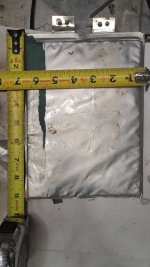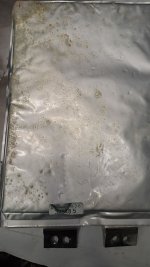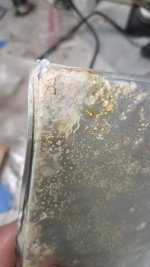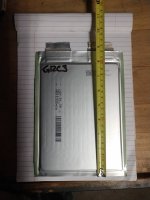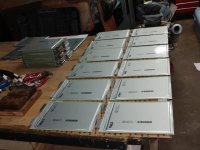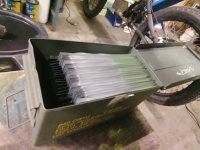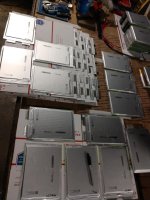You are using an out of date browser. It may not display this or other websites correctly.
You should upgrade or use an alternative browser.
You should upgrade or use an alternative browser.
What kind of pouch cells are these?
- Thread starter wice.lt
- Start date
My 1 year old battery started dying. Looks like a few cells had a leak and I need to replace but I can't identify or find a replacement. Do any of you recognize these? Also why would they have leaked from the corners? Is it mechanically over charging or something else. Size is 9x6.5 inches.View attachment 332772View attachment 332773View attachment 332774
I didn't get any comments back, so figured that maybe it was in the wrong section. Any input to why their corners are leaking? Just want to make sure it's not overcharging. Mechanically these were protected inside the frame so don't suspect someone hitting them unless while being shipped. What would you guys do? Try to source the pouch or just build/buy new one.
Looks corroded; can't tell if it's from inside the pouch's plastic or if it's from outside due to defects or damage in the pouch plastic, but the actual pouches have mechanical deformation, wrinkling, etc. Such wrinkling/etc means the cell layers are no longer attached to each other correctly, and/or there are gaps in the pouch-layer interface, so that electrolyte could be pooling in those areas and not be available in others, or even that air has gotten into the pouch thru pouch damage or defects. (air could degrade the cell chemically, as well as mechanically).
Damage can happen at the cell factory, battery build, or while riding if the pack design isn't sufficient to secure the cells and prevent it.
If it's not corrosion but is instead liquid electrolyte from inside the cells migrating thru defects or damage in the pouch's foil layer, but there is no external pouch plastic layer covering damage, then it's probably a manufacturing defect of the actual cell itself.
If there is any smell (especially acetone-like), from the cells, then whatever damage has occured has penetrated thru the entire pouch covering allowing electrolyte out and air in.
Overcharging you can test for with a voltmeter by verifying the balance of the cells, and/or the individual cell voltages vs the charger voltage once full charge is reached, vs what the cells should be being charged to for their specific chemistry/etc.
If the pack is still new and/or all the other cells are still matched to each other in characteristics, and you can find cells that match those, I'd repair the pack. But I would also make sure to test the BMS itself to be sure it is working correctly, and that it did not allow a charging or discharging problem to occur with the failed cells--it's not likely, given the physical defects/damage apparent in the pics, but it has happened.
If the cells don't match each other in characteristics, then either they have degraded enough to be problematic already, or the pack was never built matched to start with; and it is probably going to be better, performance-wise, to replace the pack with a new well-matched-cell pack.
If you can't find similar cells to what you have, at least the same chemistry and approximate capacity and physical size, it may make repairing that pack a difficult option. Cells with more capacity would be ok, but if they have less then your pack is limited by those cells. They need to be the same chemistry so they will have the same charge / discharge safety shutoff limits and your BMS can protect them correctly.
(Note that matching is not equal cell voltages, it is identical cell characteristics, internal resistance, capacity, etc., and is unfortunately apparently a rare thing for pack builders to do (probably because of the significant extra labor, equipment, and materials costs), so it is something you'd have to specifically inquire about when buying a new pack, and be sure to get actual test data for your pack's cells to prove that they are matched, since the typical response we see from pack builders is "we make sure they're the same voltage" and sometimes "we make sure they are all less than (some resistance value)" or "we make sure they are all more than (some capacity value", none of which have anything to do with matching the cells....).
Damage can happen at the cell factory, battery build, or while riding if the pack design isn't sufficient to secure the cells and prevent it.
If it's not corrosion but is instead liquid electrolyte from inside the cells migrating thru defects or damage in the pouch's foil layer, but there is no external pouch plastic layer covering damage, then it's probably a manufacturing defect of the actual cell itself.
If there is any smell (especially acetone-like), from the cells, then whatever damage has occured has penetrated thru the entire pouch covering allowing electrolyte out and air in.
Overcharging you can test for with a voltmeter by verifying the balance of the cells, and/or the individual cell voltages vs the charger voltage once full charge is reached, vs what the cells should be being charged to for their specific chemistry/etc.
If the pack is still new and/or all the other cells are still matched to each other in characteristics, and you can find cells that match those, I'd repair the pack. But I would also make sure to test the BMS itself to be sure it is working correctly, and that it did not allow a charging or discharging problem to occur with the failed cells--it's not likely, given the physical defects/damage apparent in the pics, but it has happened.
If the cells don't match each other in characteristics, then either they have degraded enough to be problematic already, or the pack was never built matched to start with; and it is probably going to be better, performance-wise, to replace the pack with a new well-matched-cell pack.
If you can't find similar cells to what you have, at least the same chemistry and approximate capacity and physical size, it may make repairing that pack a difficult option. Cells with more capacity would be ok, but if they have less then your pack is limited by those cells. They need to be the same chemistry so they will have the same charge / discharge safety shutoff limits and your BMS can protect them correctly.
(Note that matching is not equal cell voltages, it is identical cell characteristics, internal resistance, capacity, etc., and is unfortunately apparently a rare thing for pack builders to do (probably because of the significant extra labor, equipment, and materials costs), so it is something you'd have to specifically inquire about when buying a new pack, and be sure to get actual test data for your pack's cells to prove that they are matched, since the typical response we see from pack builders is "we make sure they're the same voltage" and sometimes "we make sure they are all less than (some resistance value)" or "we make sure they are all more than (some capacity value", none of which have anything to do with matching the cells....).
DogDipstick
100 kW
It is a common cell size.
Appears to be . You can find cells in .. junk yard ev cars. they are the best you can buy. They wont die, even if you buy them used.
Cheap no name cells dont have a " part number " or " serial number".. Every cell I pull from EV vehicles does.
Looks to be a common size. Generic no name cell with no serial number or julian on it. Its done, that is for sure. this is what the cell should look like.. Tight pouch, no puff. Your bad cell? Might have been LiFePo, might have been NMC, might have been LMO, I dont know from a picture.
Could be alot of different capacities, or powr outputs. I have seen 400A, 15aH cells this size, I have also seen 80A, 30aH cells this size. Depending on if its a power or an energy cell ( weight helps figure this out, if the cell itself is dead and cannot be tested).
here are some cells I have sitting around in boxxes.
Appears to be . You can find cells in .. junk yard ev cars. they are the best you can buy. They wont die, even if you buy them used.
Cheap no name cells dont have a " part number " or " serial number".. Every cell I pull from EV vehicles does.
Looks to be a common size. Generic no name cell with no serial number or julian on it. Its done, that is for sure. this is what the cell should look like.. Tight pouch, no puff. Your bad cell? Might have been LiFePo, might have been NMC, might have been LMO, I dont know from a picture.
Could be alot of different capacities, or powr outputs. I have seen 400A, 15aH cells this size, I have also seen 80A, 30aH cells this size. Depending on if its a power or an energy cell ( weight helps figure this out, if the cell itself is dead and cannot be tested).
here are some cells I have sitting around in boxxes.
Attachments
Thanks for the reply. Yes there was a smell of electrolyte (similar to acetone or alcohol) and I have replaced 2 cells (sold by original maker, but now it looks like I need 2 more and the price per pouch more than doubled, so not sure if I should keep throwing more good money after the bad. The problem is that I can not really ID these cells to look for a different supplier and have no clue what the specs are. The battery back is 20S. It does have a BMS and that's how I figured out why my performance was gone. Tough decision as it seems the prices for the battery packs have gone way up. What's the best place I should look for lose cells to buy?
Good too know. This was supposedly 72V 45AH pack from China obviously. DogDipstick would you be interested in selling 20 cells to me for rebuild?
DogDipstick
100 kW
I only have 15aH and 25ah cells right now. I am trying to get some bigger ones. I'll let you know if I can.DogDipstick would you be interested in selling 20 cells to me for rebuild?
999zip999
100 TW
If you get cheap Chinese no name cells not knowing the chemistry or the AH of the cells. It's impossible to replace or rebuild that pack. Because your cells will not be matched in power delivery or capacity.
Tell us what this is for in the amperage of your controller and the motor too.
This will tell us the demands you will have on your battery as the battery must match the controller or should be quite a bit stronger than the need of the controller. It's called the controller for a reason for.
Batteries are dumb.
Tell us what this is for in the amperage of your controller and the motor too.
This will tell us the demands you will have on your battery as the battery must match the controller or should be quite a bit stronger than the need of the controller. It's called the controller for a reason for.
Batteries are dumb.
Last edited:
Eastwood
100 kW
- Joined
- Jan 13, 2021
- Messages
- 1,479
Maybe he could test the capacity of the cells to better match them.If you get cheap Chinese no name cells not knowing the chemistry or the AH of the cells. It's impossible to replace or rebuild that pack. Because your cells will not be matched in power delivery or capacity.
Tell us what this is for in the amperage of your controller and the motor too.
This will tell us the demands you will have on your battery as the battery must match the controller or should be quite a bit stronger than the need of the controller. It's called the controller for a reason for.
Batteries are dumb.
eee291
100 kW
Are you located in the US? If so, either disassemble a scrapyard EV battery or buy something from batteryhookup.Any other suggestions guys?
999zip999
100 TW
If you buy your time you can get a good deal from battery hookup make sure the cells can deliver 15 or high amps or if tvolt cells but if you're going to put it together with 45 ampere hour cells times 20 that would be much easier . Now what chemistry do you want
Last edited:
999zip999
100 TW

A123 24V 25Ah Li-ion Lithium Battery Module, Damaged Negative Terminal Lot Of 2 | eBay
Find many great new & used options and get the best deals for A123 24V 25Ah Li-ion Lithium Battery Module, Damaged Negative Terminal Lot Of 2 at the best online prices at eBay! Free shipping for many products!
www.ebay.com
What exact controller do you have and what amperage is it programmed at ?
Just in case it hasn't already been mentioned, the pics of that cell are scary AF. Don't keep it around anything you value. Looks like a time bomb to me.
Can someone explain how the battery Ah is calculated. I see cells that claim to be 25Ah but my whole pack was supposedly 45Ah and it has 20 cells. I am not getting the math. Yes I am in US and I have been watching batteryhookup but don't see anything similar to my cells. Also what car battery is comprised of the pouches. I know Nissan has sardine can looking things and TSLA is 18650. So Bolt? Does anyone have 20 cells for sale that I can rebuild this battery in it's current format?
999zip999
100 TW
If you have 20 cells for 72 volts they are either 25 ah cells or they are 45ah. Chose one.
Do you have a link where you bought the battery from maybe there was a misunderstanding how much did you pay for the battery ?
Do you have a link where you bought the battery from maybe there was a misunderstanding how much did you pay for the battery ?
Battery came from aliexpress. A year and a half ago I think it was 650 or so.
aliexpress.us/item/2251832775726014.html?spm=a2g0o.order_list.order_list_main.10.2c3418022RbhQx&gatewayAdapt=glo2usa4itemAdapt
So the Ah are not multiplied per cell but the whole pack is only as capable as each cell?
aliexpress.us/item/2251832775726014.html?spm=a2g0o.order_list.order_list_main.10.2c3418022RbhQx&gatewayAdapt=glo2usa4itemAdapt
So the Ah are not multiplied per cell but the whole pack is only as capable as each cell?
Eastwood
100 kW
- Joined
- Jan 13, 2021
- Messages
- 1,479
So the Ah are not multiplied per cell but the whole pack is only as capable as each cell?
The amp hours are only multiplied if there’s groups of parallel.
So basically, more cells in series increases the voltage and more cells in parallel increases the amp hours
Similar threads
- Replies
- 43
- Views
- 2,236


